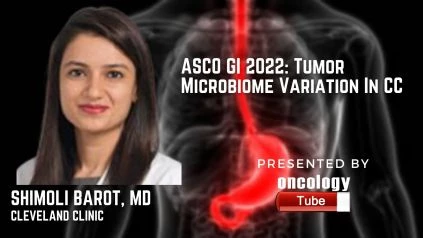Shimoli Barot, MD, Hematology/Oncology Fellow at the Cleveland Clinic. In this video, she speaks about the ASCO GI 2022 Abstract – Tumor microbiome variation in young versus average onset colorectal cancer.
Â
Origins:
Â
Young-onset colorectal cancer (yoCRC) is on the rise at an alarming rate. The rise could be due to a change in the gut microbiome. We looked examined the variations in the intratumoral microbiome between young-onset CRC (yoCRC) and average-onset CRC (aoCRC) and their clinical implications.
Â
Methodologies:
Â
Between 2000 and 2020, we identified 314 histologically confirmed cases of stage I-IV CRC that underwent surgical resection at our hospital, were diagnosed 50 years old for yoCRC and >60 years old for aoCRC and agreed to be part of a prospective biorepository. Due to nonmalignant, non-adenocarcinoma, or metastatic site specimens, 36 cases were ruled out. Fresh frozen tissue from the main tumor was evaluated, as well as paired nearby nonmalignant tissue specimens. Phyloseq was used to examine alpha and beta diversity after 16S rDNA was extracted and sequence readings were allocated to genus level amplicon sequence variants in DADA2. Analysis of variance (ANOVA), permutational multivariate analysis (PERMANOVA), linear regression, and the Wilcoxon test were among the statistical tests used. Sex and ethnicity were used as confounding factors in differential abundance and correlation analyses. Benjamini Hochberg adjustment was used to alter the correlation analysis. Fisher’s exact test was used to examine clinical differences.
Â
Findings:
Â
137 of the 278 individuals in the study had yoCRC (median age 43, range 16-49) and 141 had aoCRC (median age 73 years, range 61-95). Patients with yoCRC were more likely to come with stage III or IV cancer (29 percent vs 14 percent, p =0.002; 29 percent vs 18 percent, p =0.024, respectively), left-sided tumors (74 percent vs 58 percent, p =0.003), and neoadjuvant therapy (29 percent vs 15 percent, p =0.004). The tumor microbial alpha diversity in yoCRC was considerably higher than in aoCRC (p2.22e16, Wilcoxon rank-sum test). Beta diversity analysis revealed that the groups have significantly different genera diversity (R2=0.12, p =0.001, PERMANOVA). Lactobacillus, Bacillus, and Listeria were the most common taxa found in both groups. A substantial fluctuation in intratumoral microbiota was discovered using differential abundance analysis (ANOVA, p0.05) (Table). In yoCRC (R2 =0.36, p0.001), but not in aoCRC, correlation analysis demonstrated a link of prolonged overall survival (OS) with the presence of Akkermansia (R2 =0.36, p0.001).
Â
Outcomes:
Â
The intratumoral microbiota of yoCRC and aoCRC differed significantly, according to our findings. The presence of Akkermansia, a healthy gut bacteria, was identified in higher relative abundance in yoCRC and was linked to better OS. More research is needed to better understand the nature of the link between these bacteria and the development and consequences of yoCRC.

